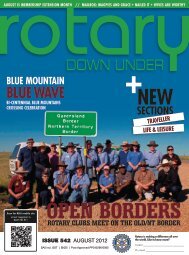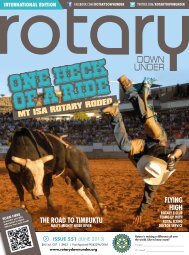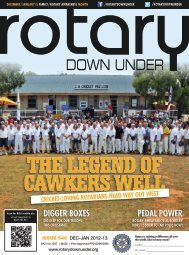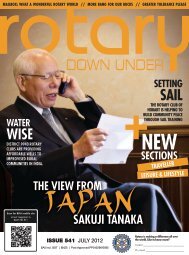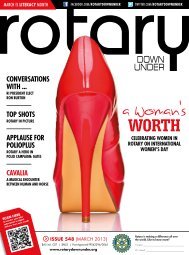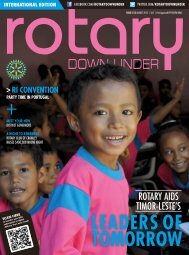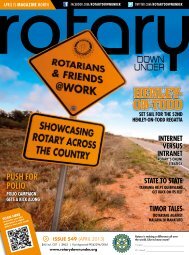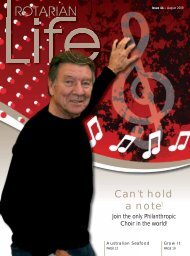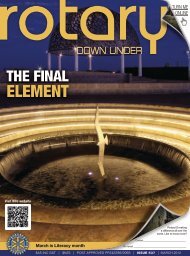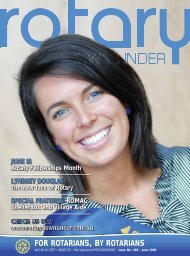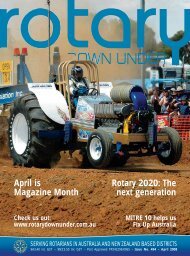May 2008 RDU online (pdf) - Rotary Down Under
May 2008 RDU online (pdf) - Rotary Down Under
May 2008 RDU online (pdf) - Rotary Down Under
Create successful ePaper yourself
Turn your PDF publications into a flip-book with our unique Google optimized e-Paper software.
Hawthorn says thanks for<br />
Cambell<br />
Cambell Gowers is lucky to be alive. Four<br />
years ago, when he was only seven years old<br />
a CT scan at The Royal Children’s Hospital<br />
in Melbourne, Vic, revealed he had a giant<br />
basilar apex aneurysm which is very rare in<br />
children.<br />
Surgeons at the RCH told his parents,<br />
Belinda and Norman, that without surgery<br />
there was a 50 per cent chance Cambell<br />
would die, with surgery he had a 50 per<br />
cent chance of survival.<br />
Due to the risk involved in the surgery,<br />
it was performed at the Royal Melbourne<br />
Hospital where there was angiographic<br />
expertise; the team included Mr Kevin So,<br />
a skilled vascular neurosurgeon from the<br />
RMH, RCH neurosurgeon Ms Wirginia<br />
Maixner and the RCH anaesthetic team.<br />
Cambell suffered a stroke on the operating<br />
table and was stabilised, but surgeons told<br />
his parents they did not expect him to<br />
pull through. They were amazed when he<br />
woke up.<br />
However, 24 hours later he was rushed<br />
back to surgery at RCH where Ms Maixner<br />
removed bone from his head to relieve<br />
pressure due to complications from the<br />
stroke. He remained in a drug-induced<br />
coma for several weeks.<br />
When he woke he was unable to walk<br />
or feed himself and it was still unknown<br />
what the long term effects of the stroke<br />
would be.<br />
Surgeons left off part of the bone flap to<br />
allow the swelling of his brain to subside.<br />
He wore a specially made helmet to protect<br />
his head and was confined to a wheelchair.<br />
Then in another setback he began having<br />
breathing difficulties and spent five days<br />
on a ventilator in intensive care. He was<br />
discharged back to the ward in time to<br />
celebrate his eighth birthday.<br />
Still without the bone flap on his skull for<br />
several weeks, he was allowed to go home<br />
and even permitted to return to school for<br />
30 minutes a day, with his mother close by.<br />
Cambell’s recovery has amazed his<br />
doctors – he had his final rehabilitation<br />
visit to the eye clinic last week. He’s a sports<br />
nut and is now playing football, cricket and<br />
basketball again.<br />
Cambell’s grandfather, Past President<br />
John Gowers and his colleagues at the<br />
THIS ROTARY WORLD<br />
Professor Wirginia Maixner, neurosurgeon at the Royal Children’s Hospital in Melbourne, with Cambell Gowers, his<br />
grandfather, PP John Gowers, of the <strong>Rotary</strong> Club of Hawthorn, Vic, and District Governor John Davis.<br />
<strong>Rotary</strong> Club of Hawthorn, Vic, were so<br />
proud of Cambell’s determination and so<br />
impressed with his care that they decided<br />
to help the hospital in a more tangible<br />
way.<br />
Cambell visited the RCH in October<br />
and, on behalf of <strong>Rotary</strong>, his grandfather<br />
pledged a donation of $200,000 to the<br />
RCH Children’s Neuroscience Centre<br />
where Cambell’s life was saved.<br />
Cambell and John will also attach a<br />
plaque in the ward in recognition of<br />
<strong>Rotary</strong>’s support.<br />
According to John, just on $152,000<br />
of the $200,000 pledge has been raised,<br />
thanks to support from District 9800,<br />
which has adopted it as a District project,<br />
along with support from corporate and<br />
individual donations.<br />
“Cambell now enjoys a normal healthy<br />
lifestyle – playing football, basketball,<br />
cricket, etc,” John said.<br />
“His only slight deficiency is a lack of left<br />
peripheral vision. However unless one was<br />
aware of it, it would be very hard to detect.” ■<br />
Eaglehawk gets skates on<br />
The <strong>Rotary</strong> Club of Eaglehawk, Vic, has<br />
proudly opened the McKern Skate Park<br />
in Canterbury Park, Eaglehawk, a project<br />
that took six years to bring to fruition.<br />
It began as an idea in 2001, followed<br />
by consultation and discussions with the<br />
young people of the community and local<br />
secondary college about the need for a<br />
skate park, what type of park and where it<br />
should be built.<br />
The young people were keen on the<br />
idea and were adamant a park was needed,<br />
but not just any park; they wanted a top<br />
class park that was suitable for learners<br />
and less experienced skaters, but would<br />
also challenge the top class skaters. They<br />
also wanted a park that could cater for<br />
competitions.<br />
They chose a perfect site that would<br />
bring them into close contact with the<br />
community – some unused parkland<br />
wedged between the YMCA public pool<br />
and Gym, the Canterbury Gardens, the<br />
football/cricket ground, a bowls club and<br />
a lake. It was going to be a hard sell to the<br />
Council and Community.<br />
The City of Greater Bendigo Council<br />
was approached and after some lengthy<br />
and at times difficult negotiations, the<br />
Council finally agreed to the project at the<br />
preferred site. There were several public<br />
meetings and the general community<br />
attitude was supportive.<br />
The next step was to come up with a<br />
suitable design. The top skate park design<br />
company in Australia, Convic Design, was<br />
asked to come to Bendigo and consult<br />
with the young people on the design they<br />
wanted.<br />
<strong>Rotary</strong> <strong>Down</strong> <strong>Under</strong>, <strong>May</strong> <strong>2008</strong>–––35




